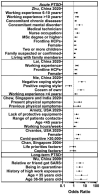Prevalence and Determinants of Immediate and Long-Term PTSD Consequences of Coronavirus-Related (CoV-1 and CoV-2) Pandemics among Healthcare Professionals: A Systematic Review and Meta-Analysis
- PMID: 33672257
- PMCID: PMC7926696
- DOI: 10.3390/ijerph18042182
Prevalence and Determinants of Immediate and Long-Term PTSD Consequences of Coronavirus-Related (CoV-1 and CoV-2) Pandemics among Healthcare Professionals: A Systematic Review and Meta-Analysis
Abstract
Background: The COVID-19 pandemic continues to rise. In order to control the COVID-19 pandemic, healthcare professionals have been subjected to increased exposure to work stress. In this systematic review, we aimed at investigating the prevalence and determinants of immediate and long-term post-traumatic stress disorder (PTSD) effects on healthcare professionals by the COVID-19 (SARS CoV-2) and SARS-2003 (SARS CoV-1) pandemics.
Methods: This systematic review was conducted according to the recommendations of the Protocols for Systemic Review and Meta-Analysis (PRISMA) statement. Only studies reporting the prevalence of PTSD (frequency, percentage) and related risk factors (adjusted odds ratio (OR)) in healthcare professionals (HCPs) during the SARS CoV-2 and SARS CoV-1 pandemics were included. The following databases were screened: Medline, Embase, PsychINFO, and Health Psychosocial Instrument (HaPI).
Results: Six of eight studies reported PTSD symptoms among healthcare professionals during the COVID-19 pandemic in China (three), Singapore (one), India (one), and the United States of America (USA) (two), while two studies reported symptoms during the SARS-2003 pandemic in China (one) and Singapore (one). Sample sizes ranged from 263 to 5062 with a combined total of 10,074 participants. All of the studies self-reported the level of exposure to coronaviruses (CoV-1 and CoV-2) and severity of PTSD. Seven studies reported the prevalence of immediate PTSD and determinants, while one study reported delayed-onset PTSD (3 years after CoV-1 pandemic). Determinants of immediate PTSD were reported for the CoV-2 pandemic, while those for long-term PTSD were reported for the CoV-1 pandemic.
Conclusions: A comprehensive understanding of the prevalence and determinants of immediate or long-term pandemic PTSD for healthcare workers can improve prevention, diagnosis, and management. Rigorous research measuring the prevalence of PTSD and its associated risk factors (adjusted OR) for the CoV-2 pandemic are envisaged. Although strategies to resolve immediate PTSD are key, long-term PTSD must not be overlooked.
Keywords: coronavirus; health personnel; immediate and long-term PTSD; odds ratio; risk factors; stress disorders.
Conflict of interest statement
The authors do not declare any commercial or financial conflicts of interest.
Figures
Similar articles
-
Prevalence and factors associated with post-traumatic stress disorder in healthcare workers exposed to COVID-19 in Wuhan, China: a cross-sectional survey.BMC Psychiatry. 2021 Nov 15;21(1):572. doi: 10.1186/s12888-021-03589-1. BMC Psychiatry. 2021. PMID: 34781901 Free PMC article.
-
Prevalence of Post-Traumatic Stress Disorder (PTSD) in Healthcare Workers following the First SARS-CoV Epidemic of 2003: A Systematic Review and Meta-Analysis.Int J Environ Res Public Health. 2022 Oct 11;19(20):13069. doi: 10.3390/ijerph192013069. Int J Environ Res Public Health. 2022. PMID: 36293650 Free PMC article.
-
Post-traumatic stress in healthcare workers during the COVID-19 pandemic: A systematic review and meta-analysis.Psychiatry Res. 2022 Nov;317:114890. doi: 10.1016/j.psychres.2022.114890. Epub 2022 Oct 8. Psychiatry Res. 2022. PMID: 36260970 Free PMC article.
-
[Health professionals facing the coronavirus disease 2019 (COVID-19) pandemic: What are the mental health risks?].Encephale. 2020 Jun;46(3S):S73-S80. doi: 10.1016/j.encep.2020.04.008. Epub 2020 Apr 22. Encephale. 2020. PMID: 32370984 Free PMC article. French.
-
Predictors of post-traumatic stress disorder among healthcare workers during the COVID-19 pandemic in Poland.Medicine (Baltimore). 2025 Mar 14;104(11):e41821. doi: 10.1097/MD.0000000000041821. Medicine (Baltimore). 2025. PMID: 40101094 Free PMC article.
Cited by
-
Emotions, Stress and Coping among Healthcare Workers in a Reproductive Medicine Unit during the First and Second COVID-19 Lockdowns.Int J Environ Res Public Health. 2022 May 12;19(10):5899. doi: 10.3390/ijerph19105899. Int J Environ Res Public Health. 2022. PMID: 35627436 Free PMC article.
-
A thematic analysis of shared experiences of essential health and support personnel in the COVID-19 pandemic.PLoS One. 2023 Mar 20;18(3):e0282946. doi: 10.1371/journal.pone.0282946. eCollection 2023. PLoS One. 2023. PMID: 36940223 Free PMC article.
-
Traumatic stress symptoms among Spanish healthcare workers during the COVID-19 pandemic: a prospective study.Epidemiol Psychiatr Sci. 2023 Aug 9;32:e50. doi: 10.1017/S2045796023000628. Epidemiol Psychiatr Sci. 2023. PMID: 37555258 Free PMC article.
-
COVID-19-related posttraumatic stress disorder in adults with lived experience of psychiatric disorder.Depress Anxiety. 2022 Jul;39(7):564-572. doi: 10.1002/da.23262. Epub 2022 May 10. Depress Anxiety. 2022. PMID: 35536094 Free PMC article.
-
How Does the COVID-19 Pandemic Affect People's Willingness to Pay for Health in the Short and Long Term? A Longitudinal Study during and after the COVID-19 Pandemic in China.Int J Environ Res Public Health. 2022 Jan 29;19(3):1568. doi: 10.3390/ijerph19031568. Int J Environ Res Public Health. 2022. PMID: 35162590 Free PMC article.
References
-
- Chew N.W.S., Lee G.K.H., Tan B.Y.Q., Jing M., Goh Y., Ngiam N.J.H., Yeo L.L.L., Ahmad A., Ahmed Khan F., Napolean Shanmugam G., et al. A multinational, multicentre study on the psychological outcomes and associated physical symptoms amongst healthcare workers during COVID-19 outbreak. Brain Behav. Immun. 2020;88:559–565. doi: 10.1016/j.bbi.2020.04.049. - DOI - PMC - PubMed
Publication types
MeSH terms
Grants and funding
LinkOut - more resources
Full Text Sources
Other Literature Sources
Medical
Miscellaneous



